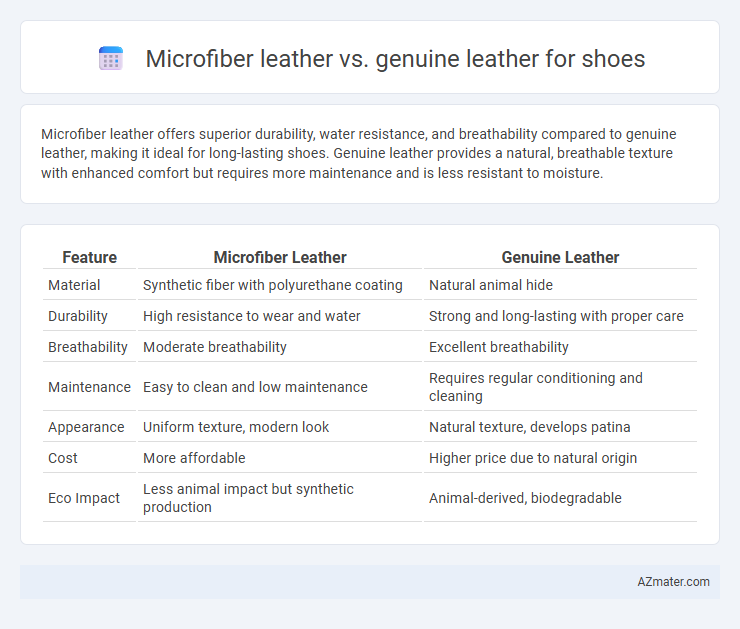Microfiber leather offers superior durability, water resistance, and breathability compared to genuine leather, making it ideal for long-lasting shoes. Genuine leather provides a natural, breathable texture with enhanced comfort but requires more maintenance and is less resistant to moisture.
Table of Comparison
| Feature | Microfiber Leather | Genuine Leather |
|---|---|---|
| Material | Synthetic fiber with polyurethane coating | Natural animal hide |
| Durability | High resistance to wear and water | Strong and long-lasting with proper care |
| Breathability | Moderate breathability | Excellent breathability |
| Maintenance | Easy to clean and low maintenance | Requires regular conditioning and cleaning |
| Appearance | Uniform texture, modern look | Natural texture, develops patina |
| Cost | More affordable | Higher price due to natural origin |
| Eco Impact | Less animal impact but synthetic production | Animal-derived, biodegradable |
Introduction to Microfiber Leather and Genuine Leather
Microfiber leather is a synthetic material made from ultra-fine polyester fibers, designed to mimic the look and feel of genuine leather while offering enhanced durability, breathability, and stain resistance. Genuine leather is derived from animal hides, providing natural texture, breathability, and long-lasting wear, but requires more maintenance and is susceptible to water damage. Shoe manufacturers increasingly choose microfiber leather for its eco-friendly production and consistent quality, while genuine leather remains preferred for premium craftsmanship and traditional durability.
Composition and Manufacturing Process
Microfiber leather, composed of ultra-fine synthetic fibers like polyurethane bonded to a microfiber backing, offers enhanced breathability and water resistance compared to genuine leather derived from animal hides through tanning and finishing processes. The manufacturing of microfiber leather involves precise layering and chemical treatments to mimic natural leather's texture and durability, while genuine leather requires time-intensive curing, tanning, and conditioning to achieve its unique characteristics. Both materials serve different performance needs in shoes, with microfiber leather providing consistent quality and genuine leather offering natural breathability and aging properties.
Durability and Longevity
Microfiber leather offers exceptional durability due to its synthetic fiber composition, resistances to cracking, and lower susceptibility to wear compared to genuine leather. Genuine leather, while initially strong and breathable, tends to develop creases and may degrade faster with prolonged exposure to moisture and friction. Choosing microfiber leather can significantly extend shoe longevity by maintaining structural integrity and appearance over time.
Comfort and Breathability
Microfiber leather offers superior breathability compared to genuine leather due to its synthetic fiber structure, allowing better air circulation and moisture wicking inside shoes. Genuine leather provides natural comfort by molding to the foot shape over time, but it retains more moisture, which can reduce overall breathability. For footwear prioritizing comfort and ventilation, microfiber leather often delivers enhanced performance, especially in warm or active conditions.
Appearance and Texture
Microfiber leather offers a consistent, smooth surface with a matte finish, mimicking the uniform appearance of genuine leather while often being more resistant to stains and scratches. Genuine leather displays natural grain patterns and variations, providing a unique, textured look that develops character over time. The texture of microfiber leather tends to feel softer and more synthetic, whereas genuine leather delivers a firmer, supple touch with breathable qualities.
Environmental Impact
Microfiber leather offers a significantly lower environmental impact compared to genuine leather by reducing water usage and chemical pollutants during production. Genuine leather processing involves extensive tanning that releases hazardous waste and contributes to deforestation through cattle farming. Choosing microfiber leather helps decrease greenhouse gas emissions and limits resource-intensive animal agriculture.
Maintenance and Care
Microfiber leather requires minimal maintenance, needing only regular wiping with a damp cloth and occasional use of mild soap to retain its appearance and durability. Genuine leather demands more intensive care, such as periodic conditioning with leather creams to prevent drying and cracking, as well as protection from excessive moisture. Both materials benefit from proper storage in a cool, dry place to maximize shoe longevity.
Cost Comparison
Microfiber leather shoes generally cost 30-50% less than genuine leather counterparts due to lower raw material and processing expenses. Genuine leather requires extensive tanning and finishing, driving up manufacturing costs and retail prices. Budget-conscious consumers often prefer microfiber leather for its affordability while still offering durability and a leather-like appearance.
Suitability for Different Shoe Types
Microfiber leather offers exceptional versatility for dress shoes, sneakers, and casual footwear due to its lightweight, water-resistant, and breathable properties, making it ideal for everyday wear. Genuine leather excels in formal shoes and high-end boots, providing durability, a classic appearance, and the ability to mold to the foot over time for enhanced comfort. Both materials suit different shoe types depending on desired aesthetics, performance requirements, and maintenance preferences.
Conclusion: Which is Better for Shoes?
Microfiber leather offers superior water resistance, durability, and easier maintenance compared to genuine leather, making it ideal for everyday, weather-exposed footwear. Genuine leather excels in breathability, natural aesthetics, and long-term comfort, appealing to traditional shoe enthusiasts seeking premium craftsmanship. Choosing between microfiber and genuine leather ultimately depends on whether durability and upkeep or natural feel and appearance are prioritized for specific shoe use.

Infographic: Microfiber leather vs Genuine leather for Shoe
 azmater.com
azmater.com